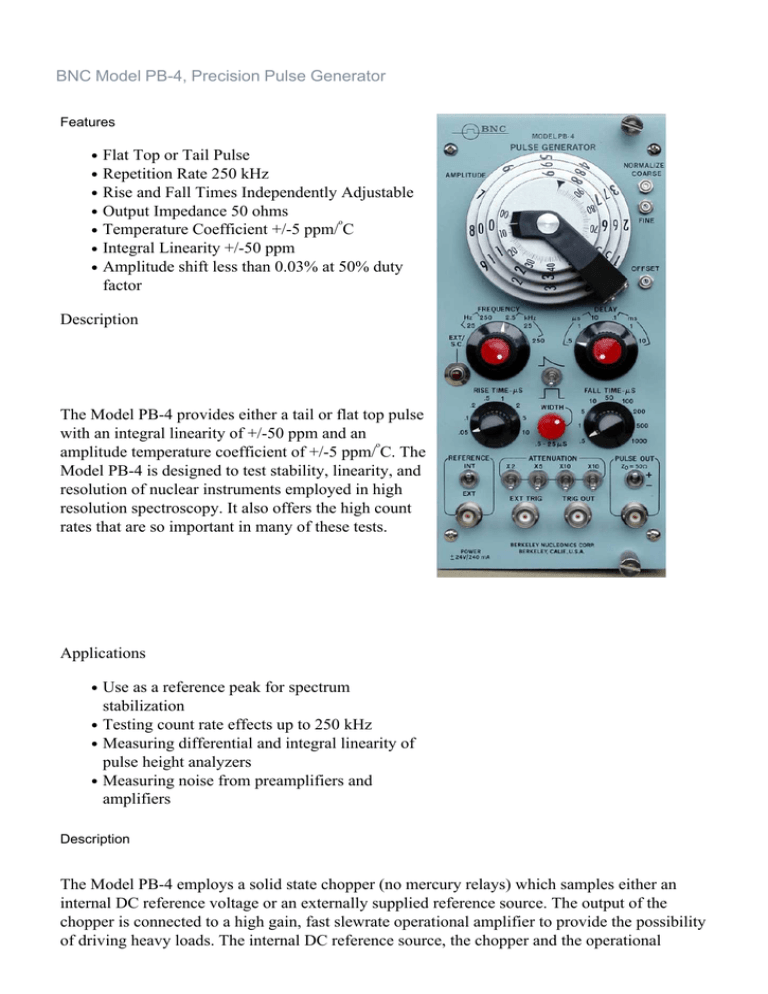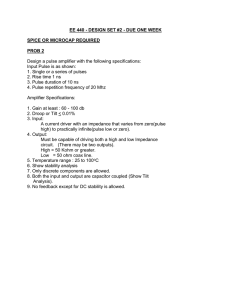BNC PB-4 Pulser specs
advertisement

BNC Model PB-4, Precision Pulse Generator Features Flat Top or Tail Pulse Repetition Rate 250 kHz Rise and Fall Times Independently Adjustable Output Impedance 50 ohms o Temperature Coefficient +/-5 ppm/ C Integral Linearity +/-50 ppm Amplitude shift less than 0.03% at 50% duty factor Description The Model PB-4 provides either a tail or flat top pulse with an integral linearity of +/-50 ppm and an o amplitude temperature coefficient of +/-5 ppm/ C. The Model PB-4 is designed to test stability, linearity, and resolution of nuclear instruments employed in high resolution spectroscopy. It also offers the high count rates that are so important in many of these tests. Applications Use as a reference peak for spectrum stabilization Testing count rate effects up to 250 kHz Measuring differential and integral linearity of pulse height analyzers Measuring noise from preamplifiers and amplifiers Description The Model PB-4 employs a solid state chopper (no mercury relays) which samples either an internal DC reference voltage or an externally supplied reference source. The output of the chopper is connected to a high gain, fast slewrate operational amplifier to provide the possibility of driving heavy loads. The internal DC reference source, the chopper and the operational internal DC reference voltage or an externally supplied reference source. The output of the chopper is connected to a high gain, fast slewrate operational amplifier to provide the possibility of driving heavy loads. The internal DC reference source, the chopper and the operational amplifier are all enclosed in a proportional control oven whose internal temperature changes only o o 0.01 C for a 1 C change in ambient. Sliding Pulse Operation A sliding pulse generator provides a pulse train of linearly increasing (or decreasing) pulses to test the differential linearity of multi-channel pulse height analyzers. To obtain a sliding pulse train from the Model PB-4 it is necessary to connect a Berkeley Nucleonics Model LG-1 Ramp Generator to its External Reference input. The solid-state chopper in the Model PB-4 samples the ramp at periodic intervals. The output of the Model PB-4 is then connected to the pulse height analyzer. If the analog-digital converter is linear and the magnetic core storage is functioning correctly, an equal number of counts will be stored in each channel and the display will be a horizontal straight line. However, if the analyzer is non-linear the display may curve up. If the magnetic core storage is defective there may be a notch in the display. The differential linearity of the sliding pulse train is better than +0.1%. The above approach is the fastest, most accurate way of testing a pulse height analyzer. Specifications INPUTS and OUTPUTS CONTROLS External Trigger: 0 to 250 kHz, requires 1 V, positive pulse, with a rise time < 1 ms. Single Cycle: Front panel push-button provides one output pulse each time the button is pressed. Amplitude: 0.0 to 10.0 V Rep Rate: 2.5 Hz to 250 kHz, continuously variable Trigger Out: 2 V positive pulse, 30 ns rise time, Delay: 0.25 ms to 10 ms. continuously variable. 0.1 us width, 50 ohms output impedance. (Delay is time between trigger out and pulse External Reference Input: +/-11 V maximum. out.) Input impedance 1 k. Primary function is to connect with an external ramp generator to provide a sliding pulse train. Tail Pulse: Rise Time (10%-90%): 0.05 ms to 10 ms, in 8 steps. Decay Time Constant (100%-37%): 0.5 ms to 1 GENERAL ms, in 9 steps. Rise and Decay Time Independently Adjustable Amplitude Characteristics: o o Stability: +/-5 ppm/ C of full scale or 20 mV/ C, for Decay Time/Rise Time >10. whichever is greater. This specification holds for Flat Top Pulse: unattenuated output. When attenuation is o Width: 0.5 ms to 25 ms, continuously adjustable. switched in, the +/-5 ppm/ C is constant, while o Pulse Top Droop: less than 0.02% with 10 ms 20 mV/ C is reduced by the attenuation factor. pulse width. Integral non-linearity: +/-0.005% (50 ppm). Integral non-linearity: +/-0.005% (50 ppm). Differential Non-Linearity: +/-0.03%. Amplitude Jitter (Resolution): 0.001% rms (10 ppm). Setability of Pulse Amplitude: 5 ppm. Line Voltage Coefficient: Less than 0.5 ppm/V Power Requirements: +/-24 V at 240 mA PHYSICAL Size: Triple-width AEC NIM module 4.05" wide x 8,70" high in accordance with TID-20893 (Rev. 3). Weight: 6.5 lbs. net; 9 lbs. Shipping. Overview Nuclear Pulse-Generators Rise and Decay Time: Same as tail pulse. Normalize: Fine and coarse front panel trimmers vary output amplitude by 20%. Polarity: Positive or Negative. Attenuators: Four toggles with X2, X5, X10, X10 attenuation, 50 ohms impedance.



